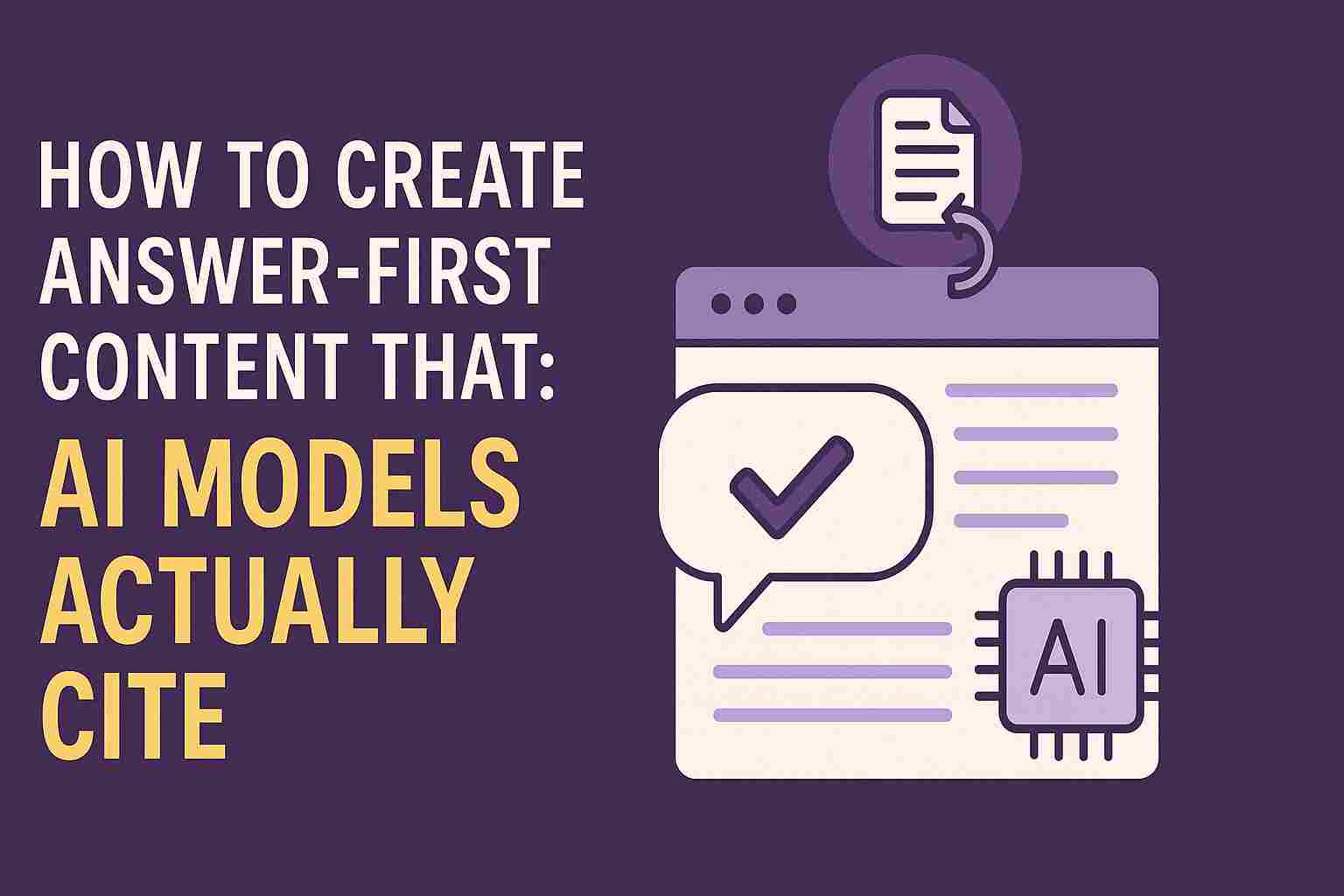Introduction
Have you ever typed a question into an AI tool and wondered why it chooses some websites to cite and completely ignores others? In today’s AI-driven search world, writing good content isn’t enough. You need answer-first content that delivers the response upfront, is super clear, and positions your brand as a trusted reference. And trust me, this matters right now more than ever. With AI summaries appearing in Google, Gemini, ChatGPT, and other search tools, brands that don’t optimize their pages for AI visibility are simply left out of the conversation. So let’s break down how you can create answer-first content that AI models love to quote.
What does answer-first content actually mean in today’s AI search?
Answer-first content is exactly what it sounds like content that gives the user a quick, clear, accurate answer before diving into explanations. Instead of building suspense, you get to the point. AI models prefer pages where the answer appears upfront because it reduces ambiguity. Public datasets, structured sections, clarity, and consistency all matter. This style directly supports AI content attribution, semantic SEO, and improves featured snippets, which is why search engines and AI tools often pick it up.
An SEO strategist I once worked with used to say, “If a reader needs to scroll three times just to get a definition, your content isn’t answer-first.” And honestly, it’s true.
Why do AI models cite some pages and ignore others even if the topic is similar?
AI models don’t think like humans. They scan the web for content that is authoritative, structured, and easy to parse. If your page uses clear answers, simple formatting, structured headings, and predictable patterns, the model trusts it more.
Here’s what usually triggers AI citations:
- Concise answers in the first sentence
- Logical formatting and question-based heading tags
- Strong context summaries
- Expert tone or references
- Clean semantic structure
- Zero fluff
Pages heavy on storytelling or too much intro often lose citation opportunities because the core answer is buried. For example, our own article on AI search trends at iTech Manthra already shows up in AI summaries because it follows this exact structure. You can check similar internal content like “How To Make Search Console Work Harder For You” inside your blog to understand the structure.
How can you structure your page so AI models pick the right information?
Think of AI models as scanners. They don’t “read” like humans they extract meaning. This means your content needs structure that machines can understand.
Here’s a simple structure that works beautifully:
Start with a clear, bold answer
Then break it down using:
- direct explanations
- bullet clarity
- short paragraphs
- semantic keywords
This positioning boosts search intent optimization, one of our secondary keywords, without forcing it.
Here’s a quick example:
Question: How long does SEO take?
Answer-first: SEO typically takes 3–6 months for noticeable growth, depending on competition, content quality, and consistency.
Then explain:
Why it takes time
What affects ranking
How to speed it up
This micro-pattern is exactly what AI prefers.
What role does semantic SEO play in getting cited by AI models?
Semantic SEO tells AI “what this page is about and why it matters.” When your content includes context-driven language, related topics, conversational cues, and structured intent, AI becomes more confident in using it as a reference.
For example:
You’re writing about answer-first content. Supporting semantic signals could include:
- ai content attribution
- topical authority
- semantic keywords
- content quality signals
- search intent optimization
Place them naturally, never forced. When AI tools see these patterns, your content becomes more citation-ready.
How can you make your brand look more credible to both humans and AI?
Authority matters. And not just for rankings AI models look at authority signals too.
Here’s what strengthens credibility:
- Consistent publishing
- Author expertise
- Clear examples
- Short expert quotes
- Clean page structure
- Zero exaggerated claims
As content strategist Lena Brooks often says, “AI doesn’t pick the loudest content, it picks the clearest.”
You can also improve authority internally by linking to related articles. For example, inside your own site you may link to your GEO vs SEO comparison article to give readers additional context.
Externally, referencing trusted industry sources (without linking to competitors) can also help. For example, you may refer to well-known SEO insights published by Moz or Ahrefs.
What steps can you follow today to make answer-first content that AI models actually cite?
Here’s a straightforward routine you can follow:
- Start every article by answering the core question in the first 2 lines.
- Use question-based subheadings to guide clarity.
- Add simple expert opinions or relatable examples.
- Focus on context semantic SEO matters.
- Keep language simple, friendly, human, and slightly imperfect.
- Add supporting keywords naturally.
- Use internal links to strengthen authority.
- Keep paragraphs tight; avoid unnecessary buildup.
- End with a clear takeaway.
Do this for 10–15 articles and you’ll start noticing that AI tools surface your content more often.
FAQ
1. What is answer-first content in simple terms?
It means giving the straight answer first and then explaining it.
2. Do AI models really prefer structured content?
Yes, they depend heavily on clean formatting and clarity.
3. Are secondary keywords still important for AI visibility?
Absolutely they help with semantic understanding.
4. Does long content perform better for AI citations?
Length matters less than clarity, structure, and relevance.
5. Can small blogs get cited by AI tools?
Yes, with answer-first writing and really clear formatting.
Conclusion
Answer-first content isn’t just an SEO hack it’s how people read online today. And now with AI-driven results on the rise, this structure helps your brand stay visible, credible, and quotable.
If you want to explore more topics like this or need help implementing it, feel free to drop your thoughts or questions in the comments section. Let’s make your content AI-ready.
